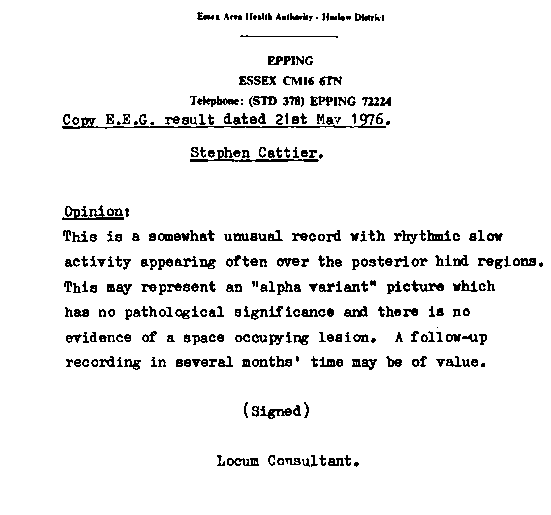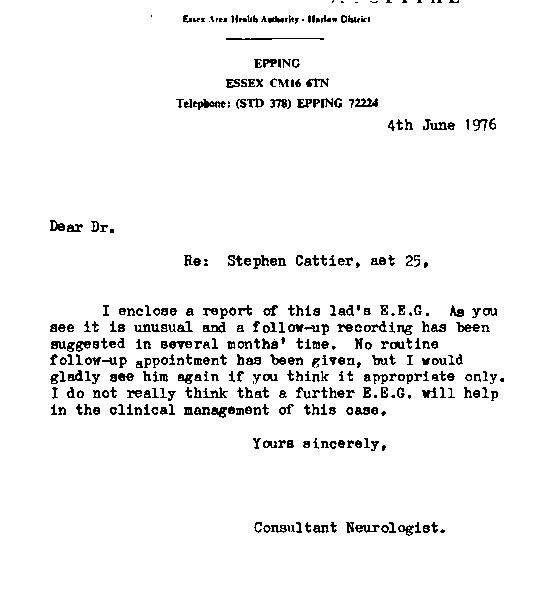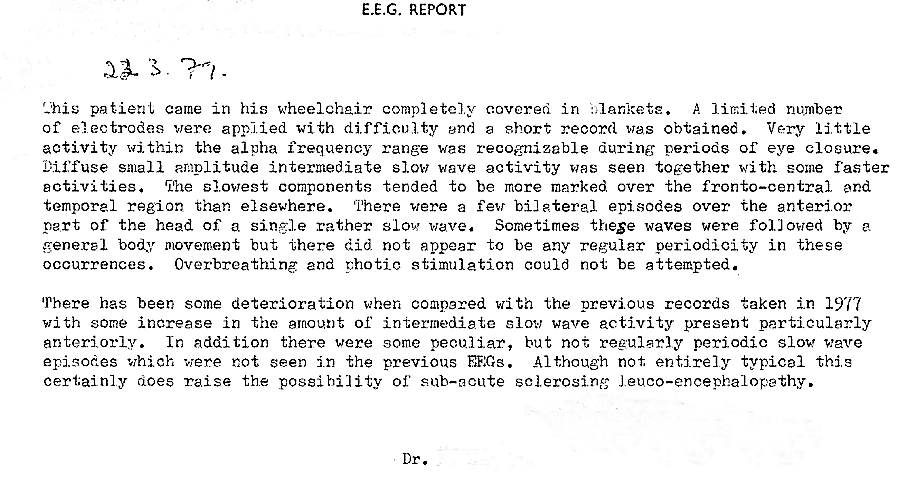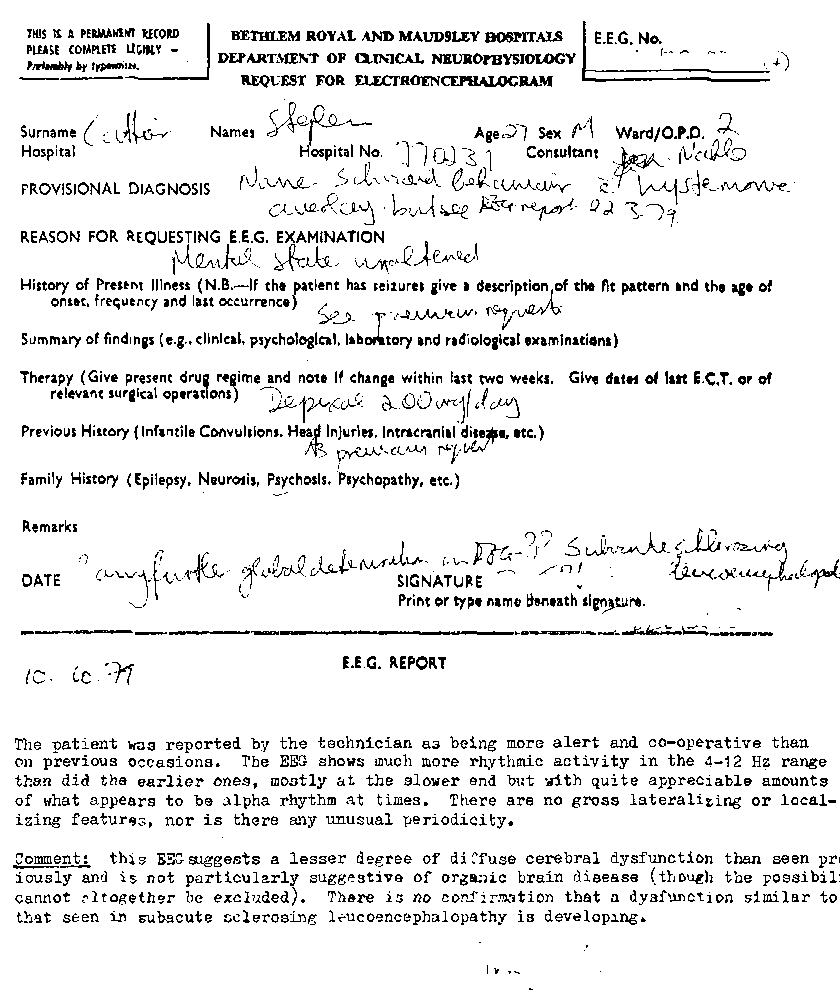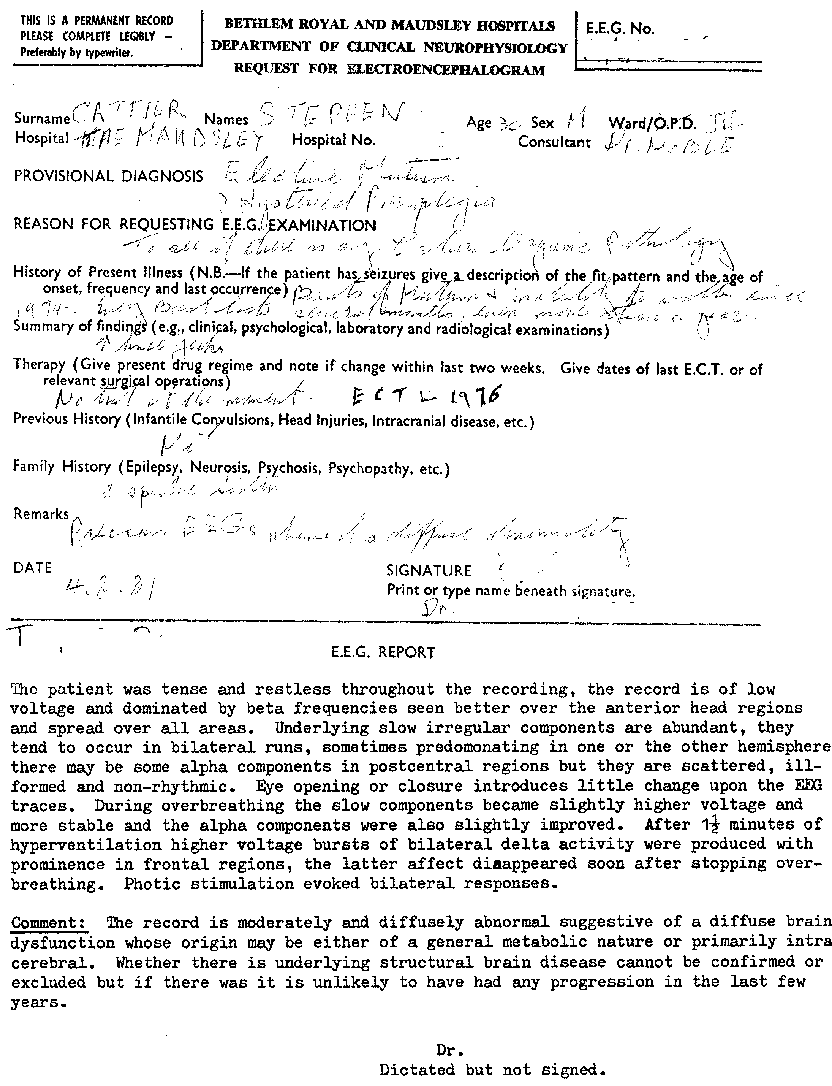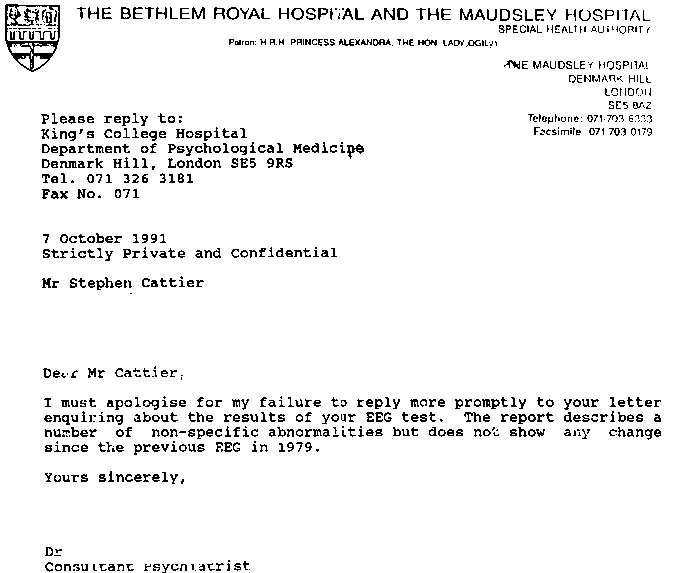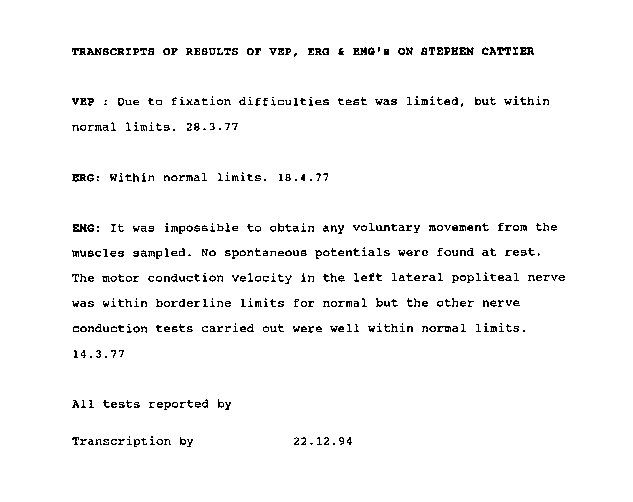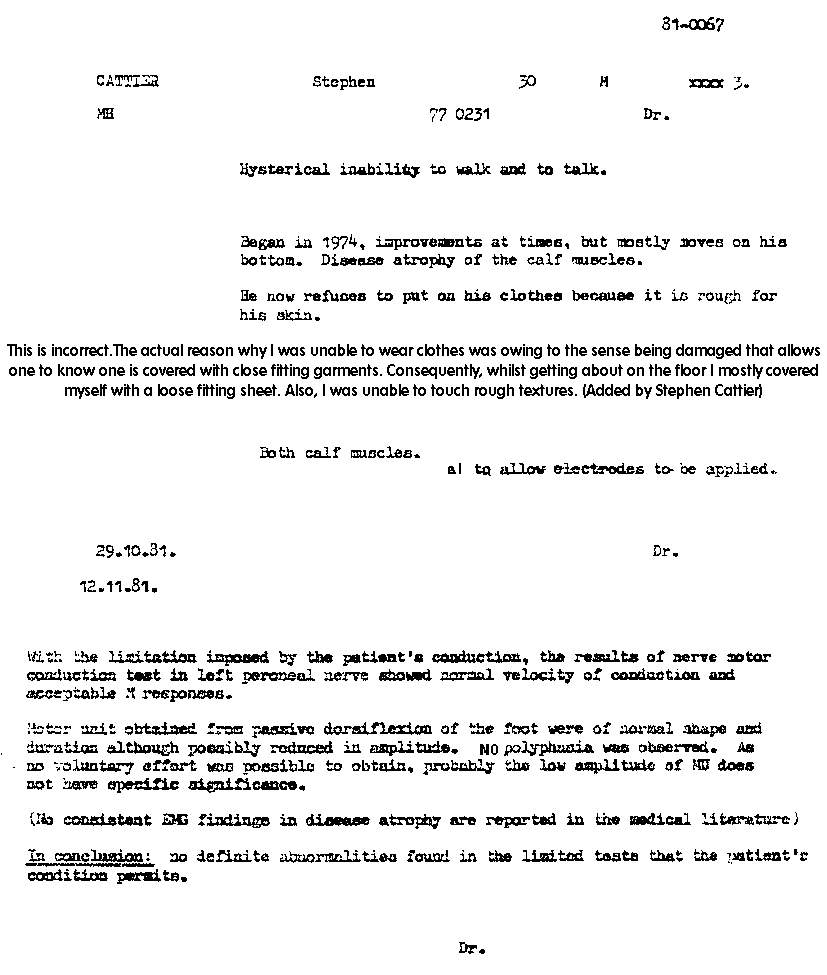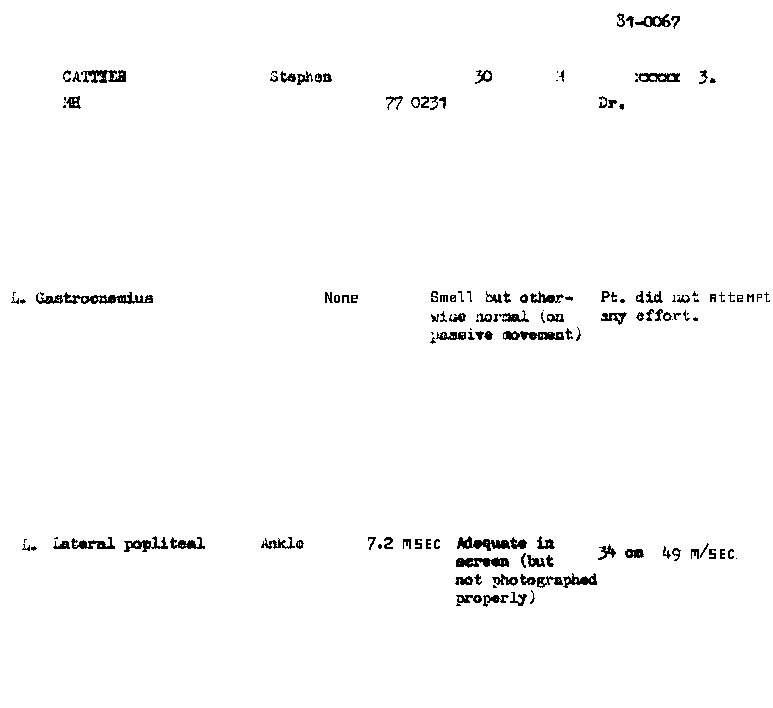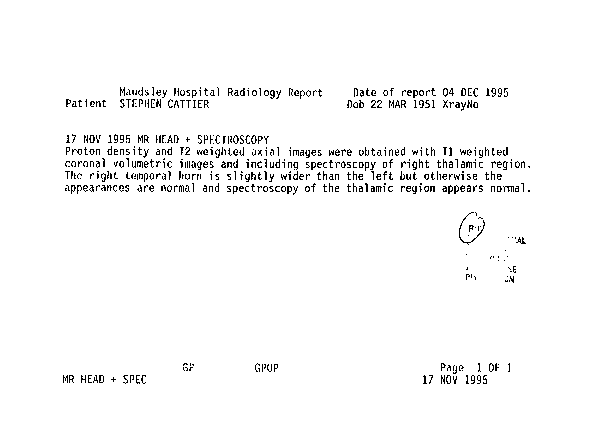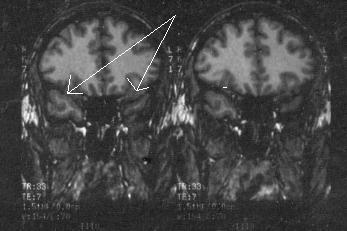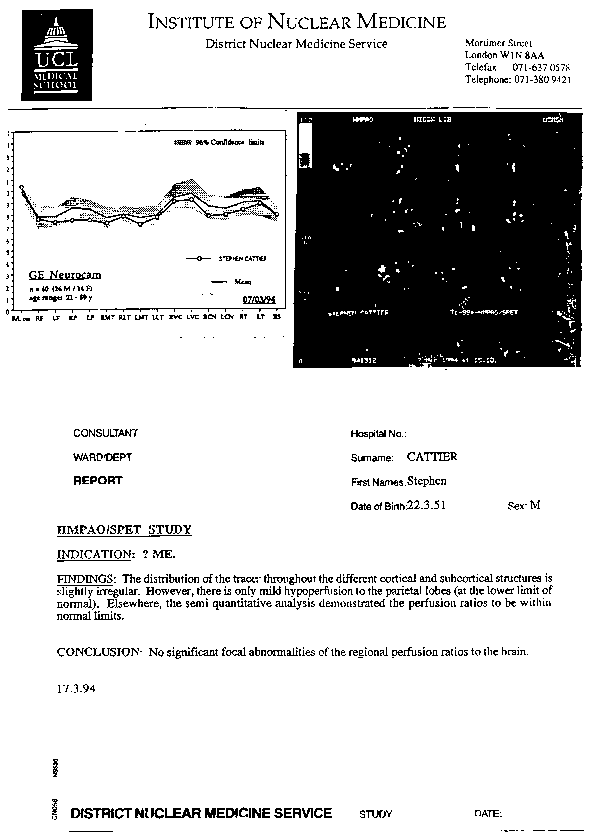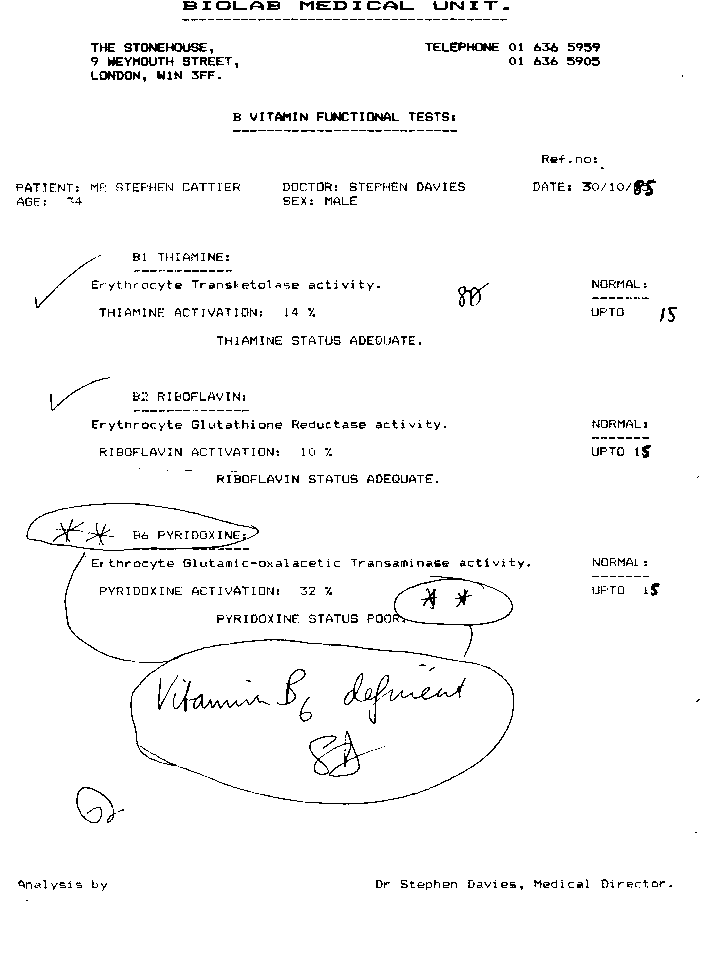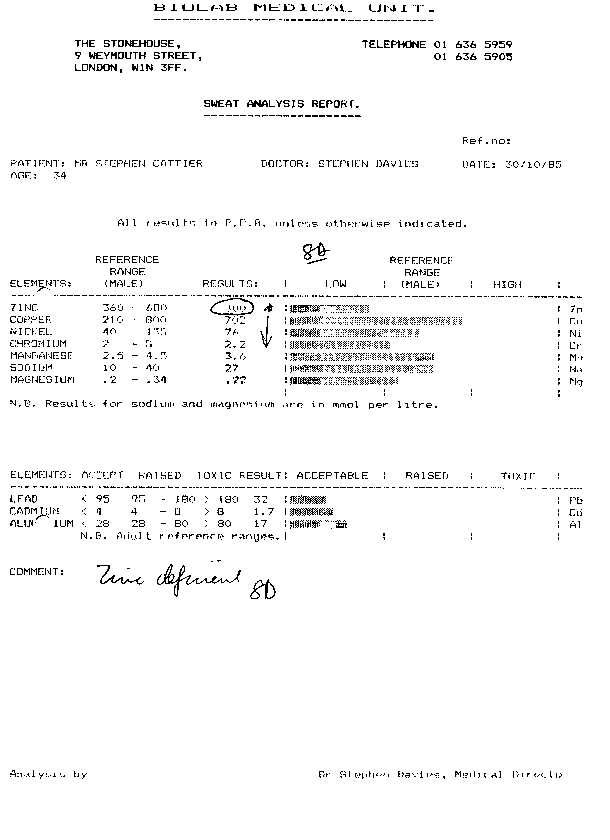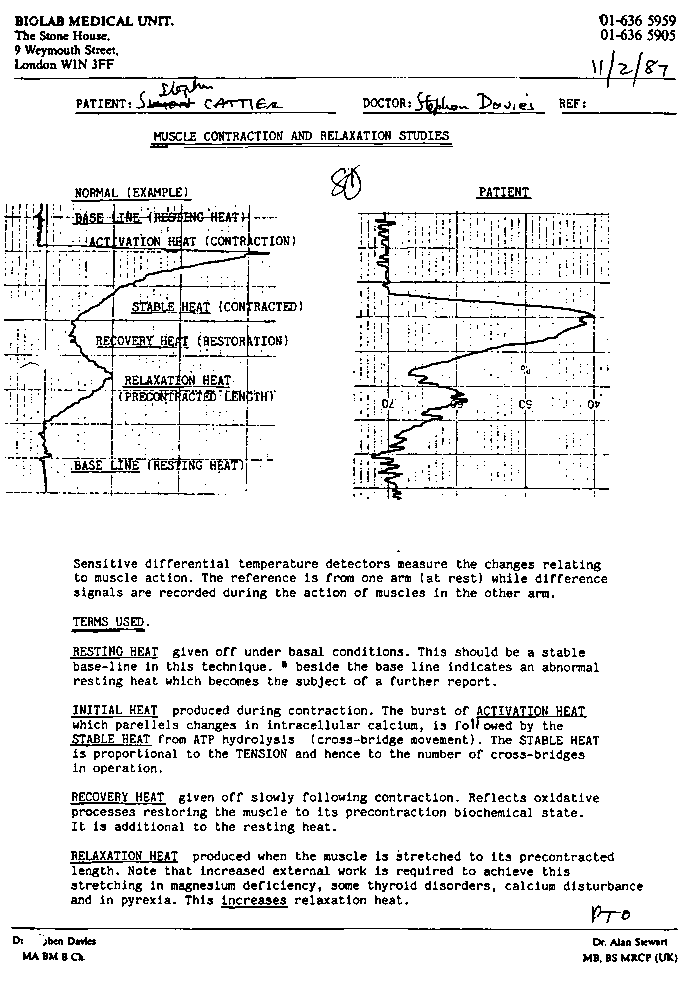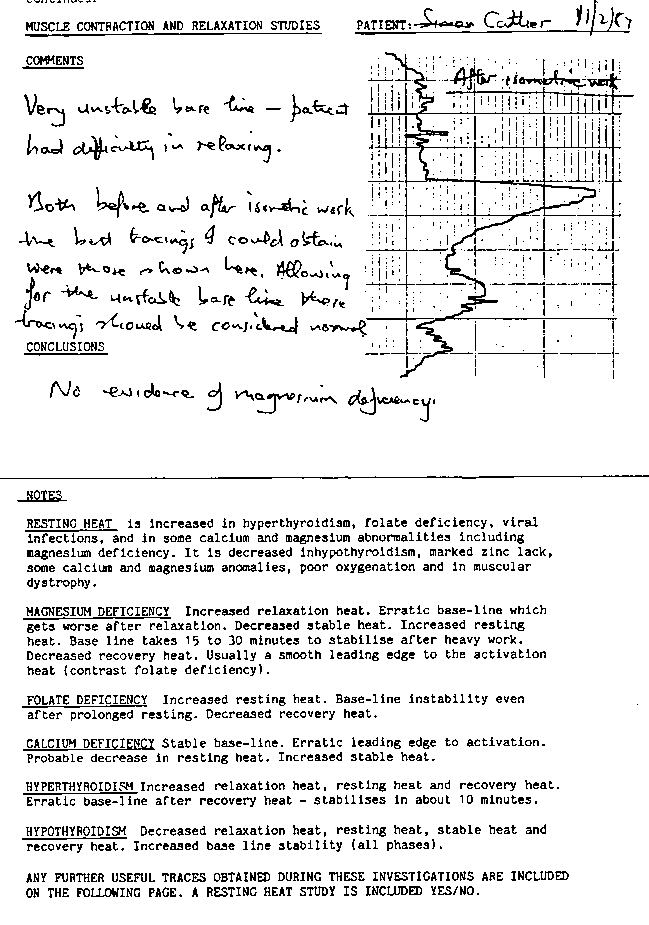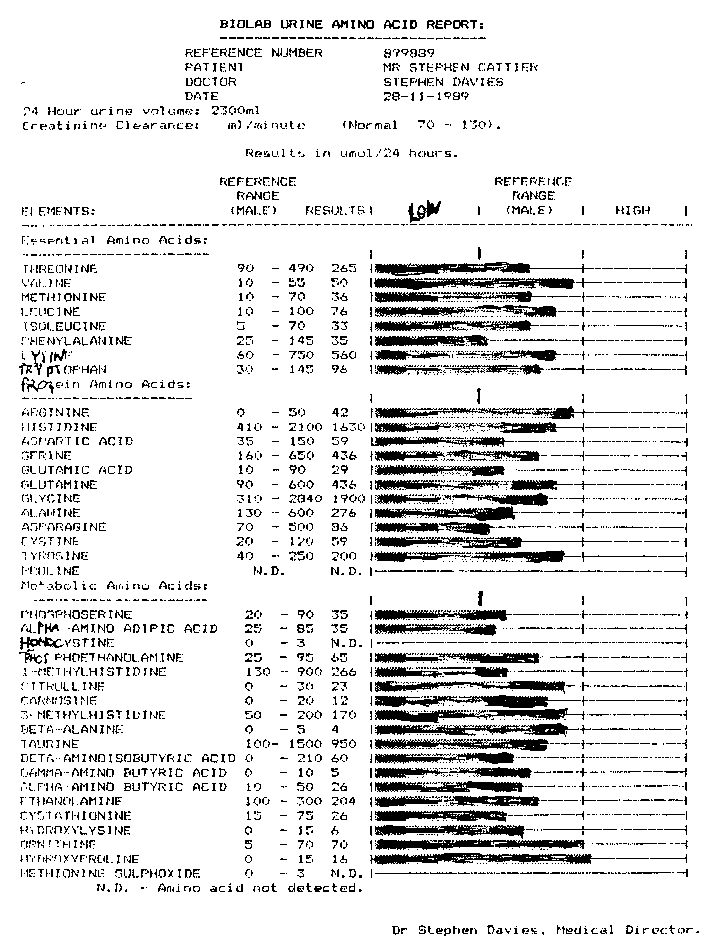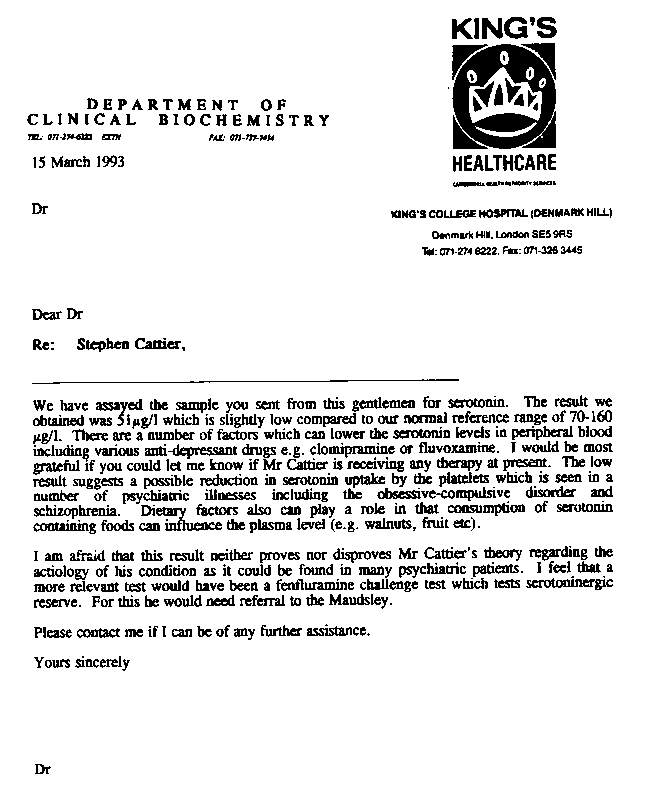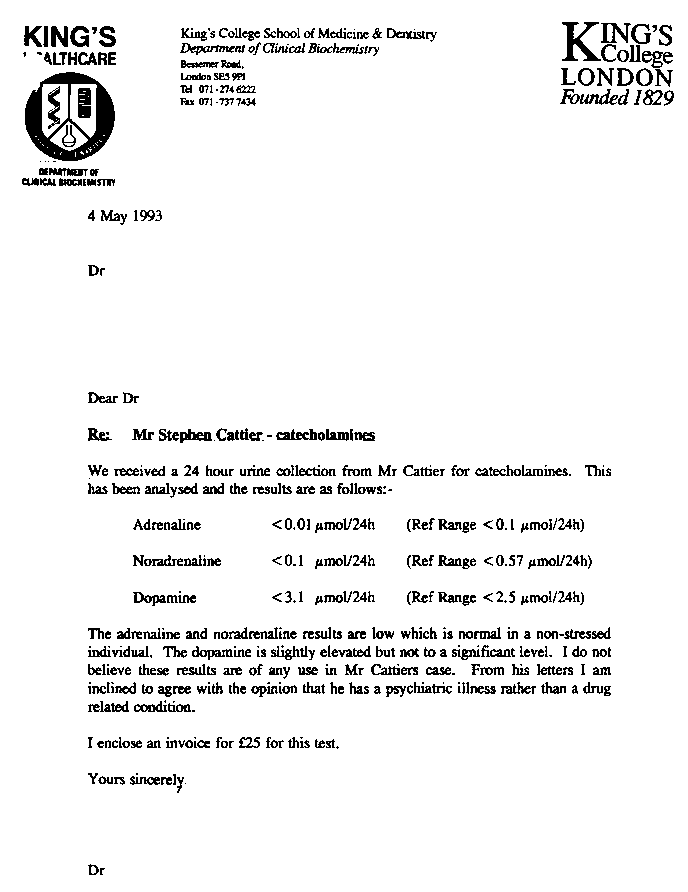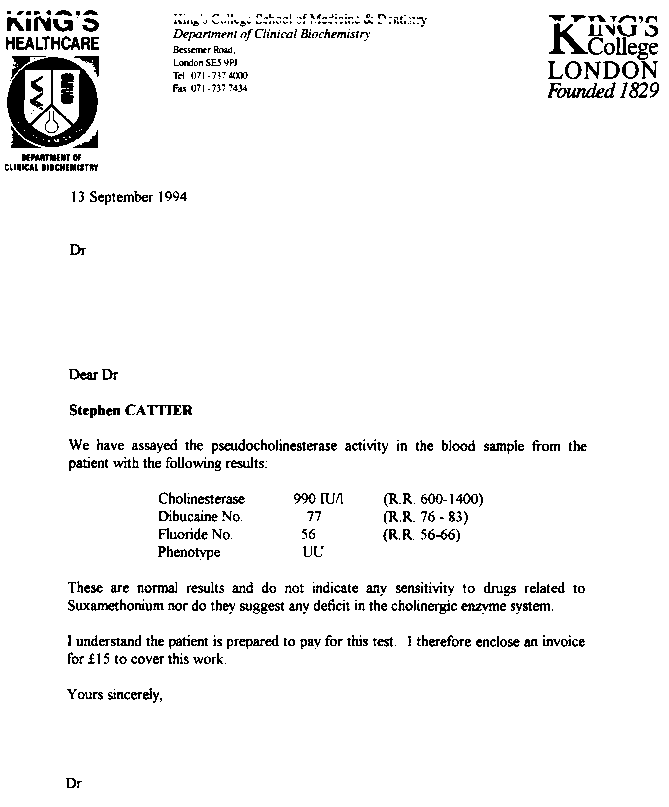Sensational New to Medical Science Brain Damage Psychogenically Dismissed. Copyright © Stephen Cattier 1998. All rights reserved.
Home Chapter 1 Chapter 2 Chapter 3 Chapter 4 Chapter 5 Chapter 6 Chapter 7 Chapter 8 Chapter 9 Chapter 10
Chapter 6. Photocopies of Most Medical Test Results of
Stephen Cattier. Doctors' reports: EEG 'Possibly...Leucodystrophy'
However, June 2006
blood test result was negative for the condition.
- EEGs somewhat abnormal i.e. 1977, "Dr. Harris thought the EEG probably abnormal and possibly due to Leucodystrophy." the 4th line.
- Last EEG, 1991.
- VRP, ERG,ENG,1977, Maudsley Hospital.
- 1981 EMG muscle test.
- MRI brain pictures and spectroscopy of thalamus privately paid for.
- SPECT Brain Scan privately paid for.
- B Vitamin functional tests privately paid for.
- Sweat analysis privately paid for.
- Muscle relaxation and contraction studies private test.
- Urine amino acid report privately paid for.
- Immunofluorescence tests for tissue antibodies privately paid for.
- Blood serotonin level privately paid for.
- Catecholamines privately paid for.
- Pseudocholinesterase activity privately paid for.
- 1975 February Dr. Irwin, consultant psychiatrist. NHS report to a consultant physician, Wanstead Hospital.
- 1975 March-June Claybury Hospital doctor's report. Inpatient.
- 1976 May Dr. M. A. Barrie, consultant neurologist. Private. St. Margaret's Hospital, Epping.
- 1976 August Claybury Hospital consultant psychiatrist's report before inpatient was transferred to Severalls Hospital.
- 1977 - '78 Seven pages of Maudsley doctors' reports. Inpatient.
- 1979 -'80 Maudsley Hospital doctors' report. Inpatient.
- 1981 Severalls Hospital psychiatrist's letter to GP after transfer to Maudsley. Inpatient.
- 1981 - 82 Maudsley doctors' report. Inpatient.
- 1983 Dr. Vicky Rippere, clinical psychologist. NHS. High Ige 493. Author 'Is not schizophrenic but cerebral allergic.'
- 1986 Prof. David Marsden, consultant neurologist. NHS, Maudsley.
- 1989 Dr. Read, consultant neurologist. Private.
- 1989 Dr. Kocen, consultant neurologist. NHS, National Hospital.
- 1990 Dr. M. Ron, consultant psychiatrist. NHS, National Hospital.
- 1997 Dr. L. J. Findley, consultant neurologist. NHS. Failed referral. Harold Wood Hospital.
- 2004 Dr. David Rickards, consultant radiologist. Private. Video urodynamics bladder pressure test.
These EEGs should have been interpreted with the author's claimed new type of neurological injury in mind. Locum Consultant was M. Schwarz, 1976.
1/ 1976. This EEG was performed when the author was in the middle of a relapse occurring which had been brought on a little earlier by him blowing his trombone for approximately twenty minutes when it used up his "battery" to a damaging level. Within one to two days he was unable to walk, speak, nor communicate but improved gradually naturally to do those things again a bit three to four weeks later. During the EEG he was able to walk but not communicate nor speak. They have recorded his age one year out. It should be 25 not 24. D.O.B. 22 March 1951.
au
The same EEG as above:
1977. Extract from report of Stephen Cattier's tests including EEG at the Maudsley Hospital Spring 1977 when Dr. Peter Noble and the late Dr. Ibiapuye Martyns-Yellowe, the former doctor's registrar, were two of his psychiatrists. Stephen's condition from the neurological disorder when he had these tests and EEGs was: unable to walk nor speak (but could scream with fright), difficulty moving and could only communicate by pointing to letters of the alphabet. Also, sensitivity to outdoor light level, temperature, music, speech, plus a mostly paralysed mind and a feeling of not being quite in the world, and an emotional mechanism that hardly worked. Ears sensitive to music, and speech. Eyes hurt to look at the TV screen and faces.
EEG 22/03/79. "...raises the possibility of subacute sclerosing leucoencephalopathy."
EEG 10/10/79
EEG 21/11/79
1981, Severalls Hospital, Colchester, Essex. Author's age is recorded one year out. Dr. David Ramster, Consultant Psychiatrist, ordered this EEG. Condition of the author caused by the neurological disorder was: maybe mostly unable to speak, could not walk, sensitive to outside light level, temperature, rough textures, weak bladder* (apparently, one suffers from the opposite with hysteria - the author was not suffering from hysteria with all due respect to the doctors), sensitive to loud sound, music and speech. Sensitive to the amount of clothes he wore. Upon admission he was unable to wear anything. Medication improved him a bit. Eyes hurt to look at the TV screen and faces. Emotional mechanism hardly worked. *It could not have been conversion hysteria because retention of the urine is the norm then and not a weak bladder.
Maudsley Hospital EEG, 4 August 1981.
2/ Condition of the author when this was done: as one sees him here in the first part of Chapter 10 except his bladder was a lot stronger then which was before his slight relapse of August 1992 when he over-spoke and it was weakened more by it, owing to the nerve link between the mind and it becoming further affected. He was unable to do any voluntary movements thus had to be in the mood to initiate movements. However, since about 1996 he has improved slightly and so been able to deliberately turn on the TV and make a drink any time he desires without it causing severe muscular spasms owing to having gradually and carefully forced the voluntary movements thus improving them like forcing a rusty hinge to move so to speak. Since 1991 his mental illness of not being in his right mind has gradually totally gone now whereas then it had a bit more to go. When he used to experience the severe spasms upon attempting a voluntary movement he never did it when undergoing an EEG to see what the result of the test would be. He should have done it but it was too difficult to do it under a testing scenario. Also, attempting to do deliberate thoughts caused bodily spasms followed by momentary total weakness. It is not so bad now since forcing the movements in 1996 but it is still worth doing while undergoing an EEG as he has never attempted deliberate thoughts during it either for the same reason. He needs encouragement to do it by the testing staff who need to believe he could be correct and wait until he is able to do the demonstration. However, he might be successful at it now that he can do deliberate movements easier than before.
5/ My dopamine system was examined by spectroscopy too but that was also ok.
This shows the author's enlarged left-hand side brain ventricle.
This shows the author's right-hand side and wider than the left temporal horn.
www.eurekalert.org/pub_releases/2002-07/pg-nrb063002.php says it 'indicates psychosis.' I am not suffering from it now since my zinc and vitamin B 6 deficiencies have been corrected for long enough. Dr. Mark Edwrds, National Hopsital, London, said in October 2012 when I saw him, that it was smaller because my head was misaligned in the scanner. That is different to the person who originally reported on the test. I did not contest it with him. I have a job to communicate.
287 kbs jpg. 587 kbs jpg.
View the author's complete brain scan from 17 November 1995.

Home Top of page Chapter 1 Chapter 2 Chapter 3 Chapter 4 Chapter 5 Chapter 6 Chapter 7 Chapter 8
